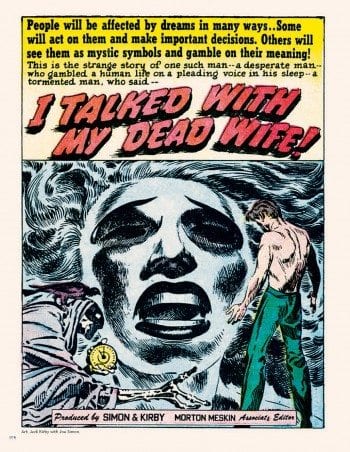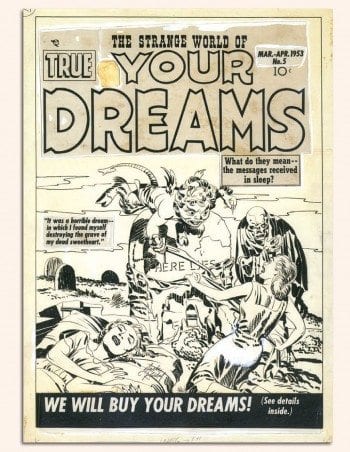“Comics are more like dreams than any other medium,” says “comics archaeologist” Craig Yoe in his introduction to The Strange World of Your Dreams, the latest book issued through his imprint at IDW. I am not sure about that grand claim; I have read the same thing said about movies, and no doubt many Surrealists thought paint and canvas was a pretty good way to capture the slippery nature of our experiences in the night-world. There can be no doubt however that dreams have provided copious subject matter and a fertile source of imagery for cartoonists throughout the history of the medium.
One example is The Strange World of Your Dreams itself, a collection of four very odd dream-themed comic books (plus some bonus materials) produced over sixty years ago by the studio of Joe Simon and Jack Kirby. Setting the scene for this peculiar material in his introduction, Yoe discusses the lineage of dream comics up to that point, including the early dream comics of Winsor McCay, not to mention less well-known efforts such as Joe Kubert’s Danny Dreams strip. More dream comics would follow, such as Nightmask from Marvel’s New Universe, Rick Veitch’s very personal Rare Bit Fiends, and of course that thing Neil Gaiman did in the '90s. Best of all are Jim Woodring’s dream comics, sadly abandoned so he could concentrate on the Frank stories.
But what about Kirby? Was he as good at illustrating dreams as he would later prove to be at visualizing bizarre cosmic worlds in his SF and superhero comics?
Well, yes. As you’d expect, he did produce good, visually arresting work, but it should be stressed (for those already reaching for their wallets) that The Strange World of Your Dreams was a product not only of Kirby but of multiple artists working under him and Joe Simon in their studio. Kirby probably drew slightly less than half of the stories in the volume, and nobody else was as good as him. Not only that, but the comic wasn’t even his idea; it was conceived by second-best artist Mort Meskin, who at the time worked for Simon and Kirby and had in the 1940s drawn an assortment of Golden Age superheroes such as Wildcat and Starman.
 Meskin was an interesting dude. Revered by Steve Ditko as a master cartoonist, he had read a bunch of Freud, spent time in a sanatorium, and even undergone Reichian therapy, which if I recall correctly involves a lot of blather about sex, “orgone energy,” and special boxes into which you are supposed to enter so that you might better attract said orgone power to your person. Did Meskin ever climb inside a Reichian “sex box?” Was Kirby drawing under the influence, flying high on the awesome power of orgone? If Yoe knows, he isn’t telling, though he does point out that Meskin’s role in creating The Strange World of Your Dreams was considered so important that Simon and Kirby credited him as “associate editor,” an honor they never bestowed on any of their other artistic collaborators.
Meskin was an interesting dude. Revered by Steve Ditko as a master cartoonist, he had read a bunch of Freud, spent time in a sanatorium, and even undergone Reichian therapy, which if I recall correctly involves a lot of blather about sex, “orgone energy,” and special boxes into which you are supposed to enter so that you might better attract said orgone power to your person. Did Meskin ever climb inside a Reichian “sex box?” Was Kirby drawing under the influence, flying high on the awesome power of orgone? If Yoe knows, he isn’t telling, though he does point out that Meskin’s role in creating The Strange World of Your Dreams was considered so important that Simon and Kirby credited him as “associate editor,” an honor they never bestowed on any of their other artistic collaborators.
All talk of orgone aside, the erotic dream is one category that is (unsurprisingly) entirely absent from The Strange World of Your Dreams, even if it is billed on the cover — cleverly designed to be soft and tactile as an old striped mattress — as “Comics meet DALI and FREUD!” Although published between 1951 and 1952, two years before Wertham’s Seduction of the Innocent hit the shelves, Simon and Kirby were businessmen running a commercial studio for profit. There are signs that they were aiming for an audience older and more varied than the one that bought boys' adventure comics (this is particularly clear when you look at the comic's ads for baldness cures and leopard-print car-seat covers, sadly not included in the print book, though available for perusal in the scans at the Digital Comics Museum), but they clearly had no intention of infringing upon the prevailing mores of society. You see the odd dress torn at the shoulder, and that’s about it as far as erotic frisson goes.
Instead The Strange World of Your Dreams offers primarily a mix of 1) “strange suspense” type stories about the mysterious world of dreams, hokey yarns with a hint of the supernatural, in which dreams inexplicably prefigure or communicate crucial facts about events in real life; and also 2) a words-and-pictures variation on those shitty books that purport to decode dream symbols for what they reveal about your personality, fortune, etc. Insofar as the comic has a protagonist, then it is the incredibly stiff and boring Richard Temple, one of the many suit-wearing pipe smoking short-haired types who occupied the pages of comics in the 1950s and '60s. He is, we are informed, a “dream detective,” and not only that, if you, the reader, send in your dream then Temple will actually PAY YOU $25 FOR THE PRIVILEGE! Considering that a copy of the comic cost 10 cents that’s a lot of gas money.
Kirby illustrates the first Temple tale, a “strange suspense” story about a man who encounters his dead wife in his dreams. Kirby plays it pretty conservatively: there are no creatures from the Id, nor is there any particularly wild imagery, but even this fairly tame encounter between a boring pipe-smoking man in an office and another man troubled by eerie dreams is rendered in the artist’s trademark ultra-melodramatic style, with hands clawing at a tormented head, grotesque contorted features and a man grabbing hold of a phone book as if he planned to bludgeon someone to death with it, etc.
Mort Meskin handles the second strip which is in the dream interpretation vein. We see a woman in a movie theater who suddenly finds herself descending in an elevator at ever greater speeds until suddenly she wakes up to find herself back in the movie theater. Temple’s interpretation: you spend too much time at the movies, the elevator represents emotional heights and depths, go out and spend some time in the REAL WORLD, dear. Yes, that’s the kind of profundity we’re dealing with, although at least that analysis does not come with the disclaimer Kirby and Simon were later to include with each strip informing the reader that actually, the dream might not mean that at all as far as you’re concerned- it all depends on the individual.
 As the book proceeds, Temple deals with a lot of anxiety dreams, and these are well suited to Kirby’s frenetic, kinetic style. In one, he draws an excessively vain young woman cycling along a city street, and in each panel a sudden transformation occurs: first the bike disappears and she starts flying; then she is derided as ugly by a crowd; the crowd becomes a set of jeering grotesques; she mutates into an obese woman in clown clothes; then the crowd pelts her with rocks as she flees. Kirby’s ultra-dynamic art, where each pose is exaggerated, combined with the radical and sudden shifts between panels really do capture the abruptly mutable aspect of dreaming. And the interpretation? Er, just enjoy the pictures.
As the book proceeds, Temple deals with a lot of anxiety dreams, and these are well suited to Kirby’s frenetic, kinetic style. In one, he draws an excessively vain young woman cycling along a city street, and in each panel a sudden transformation occurs: first the bike disappears and she starts flying; then she is derided as ugly by a crowd; the crowd becomes a set of jeering grotesques; she mutates into an obese woman in clown clothes; then the crowd pelts her with rocks as she flees. Kirby’s ultra-dynamic art, where each pose is exaggerated, combined with the radical and sudden shifts between panels really do capture the abruptly mutable aspect of dreaming. And the interpretation? Er, just enjoy the pictures.
Kirby and his collaborators seemed to get looser and more imaginative as the series went on, although the studio head undoubtedly saved his best work for the covers. The cover for #2 is an especially fun piece of surrealism: a woman is pursued by a lion with horns as eyeball-plants gaze blankly upon the scene. Now if I had the original of that, it would be heading straight for my wall — or possibly to auction. Kirby and Meskin are not the only good artists in the book, either: Al Eadeh draws an excellent sequence of men being burned alive by puritans that could have come straight from a particularly twisted Jack T. Chick comic.
Even the duller stuff is interesting in its own way. A lot of the art looks as if it was drawn by mid-century Madison Avenue advertising men of the sort that Meskin would eventually become – stiff dudes in suits, ladies in ball gowns, generic cityscapes- it’s a static, text-heavy world, in which the images are organized ruthlessly in page after page of tightly arranged panel-grids. It’s a cheapo world too: Yoe wisely opts to retains the splotchy colors of the original, which means that the book retains the signs of its origins as pulp crap for the masses. But this cheapness ultimately adds another layer of interest to The Strange World of Your Dreams, elevating it beyond a mere showcase for some obscure Kirby art. Thanks to these long stretches of narrative dullness which are periodically and abruptly disrupted by irrational violence or bizarre images of laughing heads, trapeze artists, and boys in dunce caps, the actual sensation of reading the book —which is frequently boring and confusing for stretches before startling you with sudden bursts of more interesting material — actually resembles the sensation of dreaming itself. Maybe Yoe is right, after all.







